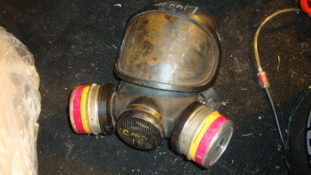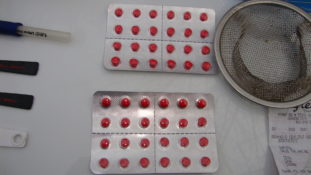
I drove up to Poga a few weeks ago with a co-worker. He’s still pretty new at the Sheriff’s Office, so I was pointing out some of the places I’d worked wrecks, been in standoffs, all those kinds of stories. I also pointed out some of the old meth labs we busted years ago. They were overgrown with weeds, torn down, and just looked dead. It was a great snapshot moment of what’s happened to the meth labs around the county. They’re dead.
That of course begs the question: if the meth labs are dead, why is there so much meth in the county? And what is the Sheriff’s Office going to do about it? I wrote about what’s happening at the national level with meth last week (if you haven’t read that, take 5 minutes and check it out), so hopefully that will answer why there’s meth in the county. This week, I want to give you a better idea of what my colleagues and I are doing to fight it.
Who Are We Arresting
The people we arrest related to meth and other drugs generally fall into one of three categories. We have users, and we also have users who start selling drugs in order to support their habit. We often see users commit property crimes to support their habit as well. Finally, we have the dealers who don’t use and are just in it for the money. For the latter, it’s a high profit, high risk business.
Arresting and charging users, including those who commit crimes to buy drugs, is primarily a task for our patrol and criminal investigations divisions. We certainly work with those divisions to gain information and to help them with cases, but for our Drug Task Force, the dealers are the primary focus of our investigations. Our job is to disrupt and cut off the supply chain for illegal narcotics, so we’ve shifted our approach to focus on arresting and bringing strong cases against the people supplying drugs.
As I mentioned in my last post, the supply chain for meth has changed over the past few years. We prosecuted the meth cooks so hard in this county that they’re all but extinct. The meth we’re seeing now comes primarily from Mexican cartels, which presents a new set of challenges for us. Instead of trying to disrupt a local supply chain, we’re fighting an international supply chain.
The Challenge
The procedure for busting a meth lab was relatively simple. Through pseudoephedrine registries and other sources, we could see who was purchasing suspicious quantities and follow the trail from there. Inevitably, the trail would lead us to the people making the meth. We’d go search the meth lab and destroy whatever dangerous chemicals we could. We did that hundreds of times. But now that the supply isn’t local, we’ve had to change our investigative approach. We have to invest a lot more long-term effort into cases in order to make an impact.

We’ve had two difficulties that have pushed us toward these slower investigations. First, arrests on the state level often don’t translate into long sentences. Our judges are bound by sentencing guidelines which often result in the offender being turned out on the streets to serve probation or other alternative sentencing as prescribed by our State Legislators. Case in point: we recently arrested one man who we’ve booked into our jail 24 times in the past 15 years. During that time, the longest amount of time he has ever served in jail has been nine months. Most of the times we’ve arrested him, he’s been back out within a month. He’s been charged with multiple drug-related and violent felonies, but the sentences he receives end up being relatively light.
In Carter County, our Criminal Court Judges and District Attorney are working towards new initiatives which are designed to rehabilitate addicts. The results so far have been impressive. The recidivism rates of offenders who complete the programs are significantly lower by comparison than those in more traditional programs such as probation.
The second major difficulty comes in cases where arrests are made. In almost all cases, after dealers are placed in jail, they are replaced by another dealer within a day or two of the arrest. So incarcerating dealers on an individual or case-by-case basis often has little impact on the overall drug picture.
These two challenges have led us to a different approach; one that’s only become truly viable in the past few years. We work with Elizabethton Police and federal agencies to investigate the entire supply chain and develop a picture of the drug network. We share information and pool our resources so that we can get a look at the big picture, and then create a strong case that will get multiple drug dealers off the streets. We often work with the federal agencies to turn these into federal cases, because those tend to result in lengthier sentences.
The downside to this style of investigation is that it takes a long time to build a case. We try to put together as much intelligence as possible about the drug operation before we move to take it down, not only because our case will be stronger but also because it provides valuable information to federal agencies operating in the region and across the nation. We’re playing the long game; the catch is the game takes a long time that way.
One of the complaints I see frequently about the Sheriff’s Office has to do with that. Someone will give us a tip about suspected drug activity, and when it’s not cleaned up before the end of the week, they assume we are doing nothing about it. That’s simply untrue. We’re observing, we’re asking questions, we’re investigating. Unfortunately, we may not be able to tell you what we’re doing so we don’t compromise our investigation, but not hearing from us and not seeing immediate results does not mean we’re ignoring you. We prefer to take a few extra months to investigate, because that will often translate into extra years and even decades of prison time for dealers.
The Result
These long-term investigations have started to bear fruit in the past two years. If you look around your community, you may notice that some of your problems have quietly gone away…to federal prison. We’ve arrested dozens of dealers, and we’ve been helping to successfully prosecute them and obtain lengthy prison stays for them. The result is some of our repeat offenders who have been committing crimes for years and even decades are now being locked up with no chance of getting out anytime soon.
Even with these successful investigations, the dealers still get replaced quickly. We can arrest 50 or 60 people involved in meth trafficking, and the supply chain will be rebuilt within a few weeks if not days. The large-scale investigations do make more of a dent than arresting individual dealers, but there are still plenty of people who will jump at the chance to make some money by selling meth.
The truth is we can’t stop meth trafficking completely. As long as there are people willing to sell it and people willing to buy it, it will still be around. What we are doing is making the meth business as difficult as possible for the people making money on it. And we’ll continue to adapt our strategy to be as effective as we can be.